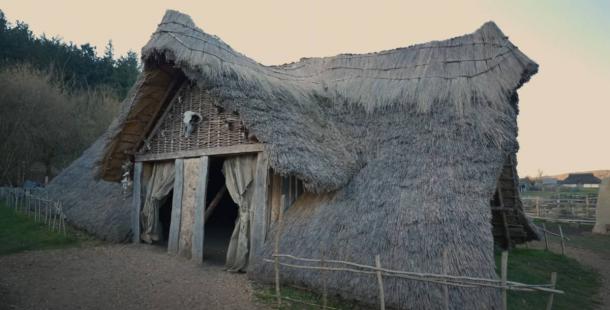
Ancient Construction Technology Discovered Under a Neolithic House
A groundbreaking discovery in Denmark has revealed evidence of an advanced technological structure dating back 5,000 years. While excavating a Neolithic site on the island of Falster, archaeologists uncovered a stone-paved root cellar for storing produce beneath an ancient dwelling. This significant find has challenged existing understandings of Neolithic life in Scandinavia, where early agricultural communities were thought to have employed simpler preservation methods.
The excavation, led by researchers from the Museum Lolland-Falster and Aarhus University, has been documented in a detailed study published in Radiocarbon.
- Hidden in the Landscape: The Unique Architectural Heritage of Icelandic Turf Houses
- Why One Neolithic Scottish Settlement Didn’t Need Any Fertilizer
A Closer Look at the Neolithic Site
The site at Nygårdsvej 3, was uncovered during construction work for a railway. It has proven to be an archaeological gold mine, well, as regards ancient architecture is concerned. Archaeologists identified two phases of house construction, both attributed to the Funnel Beaker Culture (also known as TRB or Trichterbecherkultur). This culture, which emerged around 4000 BC, marked the region’s shift from a hunter-gatherer society to a more sedentary lifestyle centered on agriculture and animal husbandry.
The houses discovered at the site followed a common architectural design of the period, known as the Mossby-type, which featured large double-span roofs supported by posts. The first house phase, made between 3080 and 2780 BC, had 38 postholes, while the second phase contained 35.
The floors of the houses were made from compacted loam, a mixture of sand and clay that provided a durable and stable surface. This is a construction material still in use in various parts of the world today.
- Moon Rituals, Head-Binding, and Ground-up Bones: Highlighting the Mysterious Beaker People
- Polish Pyramids: Ruins of Megalithic Tombs from the Time of Stonehenge Discovered in Poland

Example of a similar age primitive house inspired by the 4,000 BC Horton Neolithic House excavated in Berkshire, England. (YouTube Screenshot)
The location of the site on an elevated piece of land, away from nearby bogs and streams, indicates a forethought was used. It offered the advantages of being above flood zones and providing a wide view of the surrounding area, which would have been beneficial for both practical and defensive reasons.
More than 1,000 artifacts, including flint tools, pottery fragments, and fossilized sea urchins, were found in and around the houses, providing additional context for daily life in Neolithic Denmark.
- Huge Neolithic Cursus Linked with Isle of Arran's Sacred Stones Revealed
- Evidence of Twisted Human Brains Found in Neolithic Settlements
The Stone-Paved Cellar: An Unexpected Technological Leap
The most remarkable feature of the site is the discovery of a stone-paved, subterranean structure interpreted as a root cellar. While the use of such cellars is well documented in later periods, this is the first known example from Neolithic Denmark. If confirmed as a root cellar, this would represent a significant technological advancement for food storage in the region.
Root cellars, which keep a stable temperature by being underground, provide an ideal environment for storing food. In an agricultural society, this would have been needed for preserving crops and other resources through harsh winters and between harvests.
Preservation of food in such a manner would have greatly increased the inhabitants' chances of survival and represents a technological leap in resource management during the Neolithic period.

(a) Reconstruction drawing of the house. (b) Overview photo of the cellar feature (seen from the east, about the same orientation as the reconstruction drawing). (c) Detail photo of the cellar wall, marked by red lines, seen from the west. (Drawing and photos: Museum Lolland-Falster/Radiocarbon)
The cellar was constructed with carefully placed stones and a paved floor, measuring approximately 2 by 1.5 meters (6.5 by 5 feet). Its trapezoid shape and depth of around 40 cm (1.3 feet) below the surrounding floor level indicate considered design and construction. Although no specific evidence of what was stored in the cellar remains, the researchers still think that it was likely used for food preservation.
Other Features at the Site
In addition to the houses and cellar, the excavation revealed seven rows of postholes, possibly remnants of a fence that surrounded the settlement. Radiocarbon dating places the construction of the fence much earlier than the houses, between 3600 and 3500 BC, suggesting that the site was strategically important long before the construction of the dwellings.
The exact purpose of the fence remains unclear, though it could have served various functions, including enclosing livestock or marking territorial boundaries.
A Window into Neolithic Denmark
The discovery of the root cellar raises intriguing questions about the extent of technological knowledge among the Neolithic inhabitants of Denmark. While similar stone constructions are known from later periods, this find suggests that the region’s early agricultural communities were more advanced than previously thought. As the lead researchers noted in their paper, “The feature reliably relates to one or both house phases,” emphasizing that this was not a repurposed burial site, but rather an original construction intended for practical use.
Further excavations are planned to explore the full extent of the site and answer lingering questions about the function of the fence, the purpose of the stone-paved feature, and the overall significance of the settlement at Nygårdsvej 3. The site holds the potential to reshape our understanding of Neolithic life in Scandinavia and provide new insights into the technological capabilities of early agricultural societies..
Top image: (a) Reconstruction drawing of the house. (c) Detail photo of the cellar wall, marked by red lines, seen from the west. Source: Drawing and photos: Museum Lolland-Falster/Radiocarbon
By Gary Manners
References
Brinch M, Philippsen B, Groß D, Kanstrup M. STONE-PAVED CELLARS IN THE STONE AGE? ARCHAEOLOGICAL EVIDENCE FOR A NEOLITHIC SUBTERRANEAN CONSTRUCTION FROM NYGÅRDSVEJ 3, FALSTER, DENMARK. Radiocarbon. Published online 2024:1-25. doi:10.1017/RDC.2024.79














